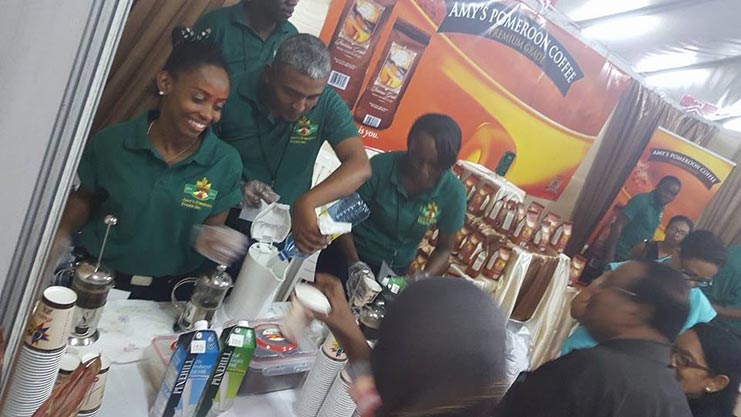Producing some of the best tasting brews in the Pomeroon
AMY’S Pomeroon Foods Inc. (APFI) was conceived in 2013 after the Chief Executive Officer (CEO) Louis Holder, who has some interests in the Pomeroon region, witnessed farmers cutting down their 75-year old coffee trees due to lack of demand from the few artisan coffee processors in the area.
Holder told the Pepperpot Magazine that his research had revealed that coffee grown in Guyana was the oldest cultivar, named Typica of the Arabica variety, in the New World having been introduced by the Dutch in their Colonies of Dutch Guiana, Berbice, Demerara and Essequibo in 1721.

“It was coffee beans from the Pomeroon region in the Essequibo which started the industry in Columbia. By 1810, then British Guiana was one of the largest exporters of coffee in the world. In that year, it exported 22 million pounds. But because the Dutch, and later the British agriculturalists, planted this coffee on low elevations, instead of its preferred high elevations, the plant yields started to decrease,” he said, adding that farmers and plantation owners found it more rewarding to switch cultivation to other crops such as sugar, except for the Pomeroon, where the cultivation of coffee continued.

Holder said that he quickly realised that few Guyanese knew the rich history of coffee in Guyana and the need to change that. In addition, he stated it seemed sacrilegious to him that this history could disappear, lost to the nation forever. Because of this situation, he formed APFI to keep coffee and other “pedigree” crops grown in the Pomeroon alive and viable.
PRODUCTS PROVIDED BY APFI
Since October 2015 when operations began at APFI, the company has concentrated on coffee – Amy’s Pomeroon Coffee. Holder said that he met with Pomeroon farmers and made two guarantees.
First, the farmers would be paid a price for its coffee cherries, 25 per cent higher than the going price, and that the company would buy all they could grow during the growing season. These were intended to be incentives to grow the industry in the river and to give the farmer an increase in income and as a result, supplies have been expanding steadily, he added.
He explained that after APFI acquires coffee cherries from farmers, its factory in the Pomeroon removes 90 per cent of the weight through a five-step process of washing (to remove defective cherries), pulping (to remove the cherry thick exocarp and mesocarp), fermenting (to remove the sticky mucilage), drying and hulling (to remove the endocarp). He added that although costly, this method, known as the wet process, produces the best tasting brews compared to processors who use a dry process (drying and hulling), or semi-dry process (pulping, drying and hulling).

“The resulting output from the wet process is coffee green beans. These are sent to Georgetown where they are roasted, ground and packaged. The problem with coffee is that its shelf-life starts deteriorating after roasting unless stored in an air-tight container to avoid contact with oxygen and moisture. APC is stored in triple-layered (Al/PET/PE) containers with one-way air valves to allow air and carbon dioxide to escape without reciprocating. The result is a high-quality deserving of its history,” Holder remarked.
CHALLENGES TO MANUFACTURING LOCAL COFFEE
The challenges are two-fold – branding a new product and weaning consumers off the inferior but convenient instant coffee.
Holder explained that initially, the company used conventional advertising methods, but after several months found little recognition of the brand – Amy’s Pomeroon Coffee. At this stage, he said, he quickly realised the business had to have a more personal approach, so he included operations to involve organising ‘Taste Events’. These, he said, were organised at Trade Expos, government ministries, corporations and retail outlets.
After just over two years of doing taste events, where potential consumers can sample the brewed coffee, the brand is becoming better known and popular with those who had the opportunity to sample. This effort is ongoing, he stated.

In enlightening the Pepperpot Magazine on the process of weaning off instant coffee, he stated that this type of coffee is popular in Guyana due to its convenience in preparation, but that it is known for its inferiority.
“In Coffee Houses, such as Starbucks, Tim Hortons, Banks DIH Quik Serv, Java Coffee, Petite Four, etc., it’s not even considered to be real coffee and therefore, not served. But because Guyanese consumers have used it for so long, they associate that taste to that of what coffee should taste like,” he posited, stating that the challenge is to introduce a new taste to consumers which takes a little longer to prepare and requires a machine to prepare the brew.
He noted that the company addressed this by giving away French Presses, a passive brewing machine that takes about four minutes to brew a cup of coffee, with the purchase of a product. Further, he said that for commercial customers, it has given them, free-of-cost, a much larger brewing machine, a 40-cup electric percolator. With the means to prepare brews from ground coffee, it is hoped that consumers will abandon instant coffee, he said.
LOBBYING FOR LOCAL CONTENT
Holder said that the APFI is also lobbying through its manufacturing association – GMSA, to introduce local laws requiring taxpayers’ funds to be used to support local products, like the USA Buy-Local Law of 1933. This, he said, is the least the country expects from its government as countries worldwide adopt more protectionist trade measures and trade wars loom.
The government and private sector should follow-up on this wave of protectionism by devising a sustainable campaign to influence consumer preferences for local production. Then, the third pillar in a buy-local campaign lies in the retail outlets where supermarkets and other outlets reserve the preferred shelf space for foreign products. Pressure should be placed on these outlets to provide local products shelf-space no less than foreign substitutes, he pointed out.
APC SUCCESS STORIES
“Perhaps, the major success story is getting Banks DIH to distribute APC to the retail outlets. That company is the largest private manufacturer and distributor in the country with an enviable distribution network. But in the end, it turned out to be a straightforward business decision for Banks DIH as it recognised the quality of APC’s production and presentation,” Holder stated.
He added that the company has also made a breakthrough with the supply of APC to major hotel and restaurant chains such as Marriott, Ramada Princess, Quik Serv, Java Coffee and Café Bellvana, Royal Castle and Woodlands Hospital, to name a few.
APFI FUTURE PLANS
Holder said that the company’s short-term plans are to introduce a local chocolate by year-end. It will be dark (85 per cent to 90 per cent cocoa) and healthy with honey substituted for refined sugars. Cocoa also has an interesting history for Guyanese. There is research, which suggests that cocoa originated in the Amazon and specifically in the Orinoco basin. New DNA research has cocoa being grouped into 10 germplasm clusters of which “Guiana” is one such cluster.
This, Holder said, is exciting as it is indicative of Guyana having its own cultivation of cocoa, “Food of the Gods”, he stated.
He said that the company plans to make a healthy product using between 85 per cent to 90 per cent cocoa, adding that the more cocoa content, the healthier is the chocolate as cocoa is packed with antioxidants. Further, he said that instead of refined sugars, the company intends to substitute honey as sugary foods, which are now viewed as a health risk, causing obesity in people.
According to Holder, next year, APFI will commence tests on its “Coffee Mate” with the use of coconut milk powder and local nut butter like Nutella, but with coconut butter substituted for hazelnut butter.
(mercilinburke2017@gmail.com)



.jpg)








